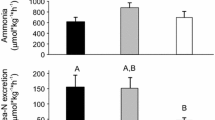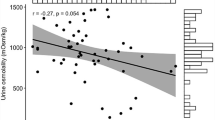Summary
- 1.
Quantitative sodium and water budgets have been constructed for the estuarine crocodile,Crocodylus porosus, unfed in sea water in the laboratory.C. porosus is homeostatic for exchangeable Na in sea water but is unable to achieve homeostasis of plasma Na concentration or total body water when fasted.
- 2.
The lingual salt glands account for 55% of the total Na efflux compared with only 2% excreted by the renal/cloacal complex. The urinary system appears to be the principal route for excretion of K.
- 3.
The integument is essentially impermeable to Na but permeable to water, as in other estuarine/marine reptiles. Much of the Na and water exchange across the skin appears to take place across cephalic epithelia, particularly the buccal mocosa.
- 4.
The permeable buccal mucosa is costly in terms of direct water loss and indirect losses tied to excretion of excess Na. Lowering of buccal permeability may be limited by the necessity to retain some functional glandular tissue and sensory organs in the mouth.
- 5.
There is no evidence to suggest thatC. porosus feeds selectively on invertebrate prey of low Na or high water content despite the apparent selective advantage of minimizing water losses associated with extra-renal Na excretion.
Similar content being viewed by others
Abbreviations
- BW :
-
body weight
- TBW :
-
total body water
- THO :
-
tritiated water
- ExNa :
-
exchangeable sodium
- SA :
-
surface area
References
Bennett AF, Dawson WR (1976) Metabolism. In: Gans C, Dawson WR (eds) Biology of the reptilia. Physiology A. Academic Press, New York, vol 5, pp 127–223
Birkhead WS, Bennett CR (1981) Observations of a small population of estuarine-inhabiting alligators near Southport, North Carolina. Brimleyana 6:111–117
Densmore LD (1981) Biochemical and immunological systematics of the order Crocodylia. PhD thesis, Univ of Houston
Densmore LD, Dessauer HC (1982) Low protein divergence of species within the circumtropical genusCrocodylus—result of a post-Pliocene transoceanic dispersal and radiation? Fed Proc 41/4:Abstract #4293
Dunson WA (1970) Some aspects of electrolyte and water balance in three estuarine reptiles, the diamond back terrapin, American and ‘saltwater’ crocodiles. Comp Biochem Physiol 32:161–174
Dunson WA (1978) Role of the skin in sodium and water exchange of aquatic snakes placed in sea water. Am J Physiol 235:R151–159
Dunson WA (1979) Control mechanisms in reptiles. In: Gilles R (ed) Mechanisms of osmoregulation in animals. John Wiley, New York, pp 273–322
Dunson WA (1982) Osmoregulation of crocodiles: salinity as a possible limiting factor toCrocodylus acutus in Florida Bay. Copeia 1982:374–385
Dunson WA, Dunson MK (1973) Convergent evolution of sublingual salt glands in the marine file snake and the true sea snakes. J Comp Physiol 86:193–208
Dunson WA, Robinson GD (1976) Sea snake skin: permeable to water but not to sodium. J Comp Physiol 108:303–311
Ellis TM (1981) Tolerance of seawater by the American crocodile,Crocodylus acutus. J Herpetol 15:187–192
Evans DH, Ellis TM (1977) Sodium balance in the hatchling American crocodile,Crocodylus acutus. Comp Biochem Physiol 58A:159–162
Green B, Dunsmore JD (1978) Turnover of tritiated water and22sodium in captive rabbits. J Mammal 59:12–17
Grigg GC (1981) Plasma homeostasis and cloacal urine composition inCrocodylus porosus caught along a salinity gradient. J Comp Physiol 144:261–270
Grigg GC, Taplin LE, Harlow P, Wright J (1980) Survival and growth of hatchlingCrocodylus porosus in saltwater without access to fresh drinking water. Oecologia 47:264–266
Kirschner LB (1970) The study of NaCl transport in aquatic animals. Am Zool 10:365–376
Messel H, Wells AG, Green WJ et al. (1979–81) Surveys of tidal river systems in the Northern Territory of Australia and their crocodile populations. A series of 17 monographs. Pergamon Press, Sydney
Nagy KA, Costa DP (1980) Water flux in animals: analysis of potential errors in the tritiated water method. Am J Physiol 238: (Regulatory Integrative Comp Physiol 7): R454-R465
Neill WT (1971) The last of the ruling reptiles alligators, crocodiles and their kin. Columbia Univ Press, New York
Ogden JC (1978) Status and nesting biology of the American Crocodile,Crocodylus acutus, (Reptilia, Crocodilidae) in Florida. J Herpetol 12:183–196
Robinson GD, Dunson WA (1976) Water and sodium balance in the estuarine Diamondback Terrapin (Malaclemys). J Comp Physiol 105:129–152
Stokes GD, Dunson WA (1982) Permeability and channel structure of reptilian skin. Am Physiol Soc 242:F681–689
Taplin LE (1982) Osmoregulation in the estuarine crocodile,Crocodylus porosus. PhD thesis, University of Sydney
Taplin LE (1984a) Evolution and zoogeography of the crocodilians: a new look at an ancient order. In: Archer M, Clayton G (eds) Vertebrate zoogeography and evolution in Australasia. Hesperian Press, Perth
Taplin LE (1984b) Drinking of fresh water but not sea water by the estuarine crocodile (Crocodylus porosus). Comp Biochem Physiol 77A:763–767
Taplin LE (1984c) Homeostasis of plasma electrolytes, sodium and water pools in the estuarine crocodile,Crocodylus porosus, from salinities of 0–60‰. Oecologia 63:63–70
Taplin LE, Grigg GC (1981) Salt glands in the tongue of the estuarine crocodile,Crocodylus porosus. Science 212:1045–1047
Taplin LE, Grigg GC, Harlow P, Ellis TM, Dunson WA, (1982) Lingual salt glands inCrocodylus acutus andC. johnstoni and their absence fromAlligator mississipiensis andCaiman crocodilus. J Comp Physiol 149:43–47
Taylor JA (1977) The foods and feeding habits of sub-adultCrocodylus porosus Schneider, in northern Australia. MSc thesis, University of Sydney
Taylor JA (1979) The foods and feeding habits of sub-adultCrocodylus porosus Schneider in northern Australia. Aust Wildl Res 6:347–359
Whitaker R, Whitaker Z (1978) Preliminary crocodile survey —Sri Lanka. J Bombay Nat Hist Soc 76:66–85
Author information
Authors and Affiliations
Rights and permissions
About this article
Cite this article
Taplin, L.E. Sodium and water budgets of the fasted estuarine crocodile,Crocodylus porosus, in sea water. J Comp Physiol B 155, 501–513 (1985). https://doi.org/10.1007/BF00684681
Accepted:
Issue Date:
DOI: https://doi.org/10.1007/BF00684681




